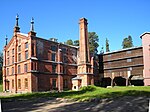This article lists the sites registered with World Heritage in Finland.
Understand
Listing
| Site | Type | Criterion | Description | Drawing | |||||||||||||||||||||
|---|---|---|---|---|---|---|---|---|---|---|---|---|---|---|---|---|---|---|---|---|---|---|---|---|---|
| 1 Elder Rauma | Cultural | (iv) (v) | Located on the Gulf of Bothnia, the town of Rauma is one of Finland's oldest ports. It is built around a Franciscan monastery of which there remains the Holy Cross Church, which dates from the mid-15th century.e century. It is an exceptional example of an old Nordic town built in wood. Although ravaged by fire at the end of the 17th centurye century, it has protected its ancient architectural heritage in local style. | _zostało_wpisane_na_listę_UNESCO_-_panoramio.jpg/150px-Stare_centrum_miasta_–_Vanha_Rauma_(Stara_Rauma)_zostało_wpisane_na_listę_UNESCO_-_panoramio.jpg) | |||||||||||||||||||||
| Struve Geodesic Arc (10 countries) | Cultural | (ii) (iii) (vi) | | ||||||||||||||||||||||
| 2 Suomenlinna Fortress | Cultural | (iv) | Built in the second half of the 18th centurye century by the Swedes on a group of islands located at the entrance to the harbor of Helsinki, the fortress constitutes a particularly interesting example of European military architecture of the time. |  | |||||||||||||||||||||
| 3 Sammallahdenmäki Bronze Age burial site | Cultural | (iii) (iv) | The 30 or so granite burial mounds in the Bronze Age cemetery of Sammallahdenmäki provide exceptional testimony to the funeral practices and social and religious structures of northern Europe over three millennia ago. | _02.jpg/150px-Sammallahdenmäki_(gravrösen_från_bronsåldern)_02.jpg) | |||||||||||||||||||||
| 4 Verla Wood and Cardboard Processing Plant | Cultural | (iv) | The Verla Lumber Mill and associated residential area are an exceptional and remarkably well-preserved example of a small-scale rural industrial facility dedicated to the manufacture of pulp, paper and board. This type of installation which prospered in Northern Europe and North America in XIXe and at the start of XXe century has almost completely disappeared today. |  | |||||||||||||||||||||
| 5 Old Church of Petäjävesi | Cultural | (iv) | The Old Church in Petäjävesi, Central Finland, built of coniferous logs in 1763-1765, is a rural Lutheran church representative of an architectural tradition unique to eastern Scandinavia. The church combines the Renaissance design of a church with a centered plan and the older forms derived from the groin vaulted ceilings of the Gothic period. |  | |||||||||||||||||||||
| High Coast / Kvarken archipelago shared between Sweden and Finland | Natural | (viii) | The Kvarken Archipelago (Finland) and the Upper Coast (Sweden) are located in the Gulf of Bothnia, which extends the Baltic Sea to the north. The 5,600 islands and islets are mainly distinguished by the curious dented crested moraines, or Geer moraines, formed by the melting of the continental ice sheet formed between 10,000 and 24,000 years ago. The Kvarken Archipelago continuously rises from sea level due to rapid glacial-isostatic recovery, when a land previously compressed by the weight of a glacier rises after the latter has disappeared. of this recovery rate in the region, one of the highest in the world. With the advancing coastline, islands appear and unite, peninsulas grow, lakes form from bays and become swamps and peaty fens. The High Coast has also been largely shaped by the combination of glaciation processes, retreating glaciers and the emergence of new lands. Since the final retreat of the high coast ice, 9,600 years ago, the rise has been in the order of 285 m, which corresponds to the most significant obvious “rebound” ever observed. The High Coast is an exceptional site for understanding the important processes that formed glaciers and the earth's surface uplift zones. |  | |||||||||||||||||||||
Criteria legend
| |||||||||||||||||||||||||
